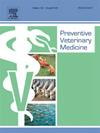The impacts of household factors and proxies of human social determinants of health on dog behavior
IF 2.2
2区 农林科学
Q1 VETERINARY SCIENCES
引用次数: 0
Abstract
Social determinants of health (SDOH) have an enormous impact on human health and behavior, although their possible effects on canine behavior have received limited scientific attention. The goals of this observational cohort study were to identify associations between canine behavior, household environments, and zip code-level proxies for human SDOH, and to explore longitudinal impacts on behavior. We used an existing dataset of C-BARQ behavioral assessments from 3044 golden retrievers in the United States, including up to eight years of data per dog collected between 2012 and 2023. The data were analyzed using linear mixed effect models and generalized estimating equations. We found dogs from single-dog homes had increased odds of dog-directed fear (OR 1.44, 95 % CI 1.30–1.61) and poorer trainability, particularly during early adulthood (F=14.32, p < 0.001). Sleeping in the owners’ bed was associated with increased aggression towards strangers, and a greater reduction in trainability (F=20.71, p < 0.001) and energy with age (F=8.20, p = 0.004). Dogs in the most densely populated neighborhoods had greater odds of showing aggression to strangers compared with dogs in sparsely (OR 0.78, 95 % CI 0.63–0.95) or moderately populated neighborhoods (OR 0.73, 95 % CI 0.60–0.90). Together, our findings illustrate how conspecific relationships, human interactions, home and neighborhood environments affect dog behavior, and show, for the first time, that household characteristics and ownership behaviors have differential impacts on behavior across the lifespan. Future studies including more diverse human and canine populations are needed to provide further insights about the impacts of SDOH on dog health and welfare.
家庭因素和人类社会健康决定因素对狗行为的影响
健康的社会决定因素(SDOH)对人类健康和行为有着巨大的影响,尽管它们对犬类行为的可能影响受到了有限的科学关注。本观察性队列研究的目的是确定犬类行为、家庭环境和邮政编码水平对人类SDOH的影响,并探讨对行为的纵向影响。我们使用了来自美国3044只金毛寻回犬的现有C-BARQ行为评估数据集,包括2012年至2023年间收集的每只狗长达8年的数据。采用线性混合效应模型和广义估计方程对数据进行分析。我们发现,来自单狗家庭的狗有更高的狗引起恐惧的几率(OR 1.44, 95 % CI 1.30-1.61)和更差的可训练性,特别是在成年早期(F=14.32, p <; 0.001)。睡在主人的床上与对陌生人的攻击性增加有关,与可训练性降低有关(F=20.71, p <; 0.001),与年龄有关(F=8.20, p = 0.004)。与人口稀少(OR 0.78, 95 % CI 0.63-0.95)或人口中等(OR 0.73, 95 % CI 0.60-0.90)的社区相比,人口最密集社区的狗对陌生人表现出攻击的几率更大。总之,我们的研究结果说明了同种关系、人类互动、家庭和邻里环境如何影响狗的行为,并首次表明,家庭特征和主人行为对整个生命周期的行为有不同的影响。未来的研究需要包括更多样化的人类和犬类种群,以进一步了解SDOH对狗的健康和福利的影响。
本文章由计算机程序翻译,如有差异,请以英文原文为准。
求助全文
约1分钟内获得全文
求助全文
来源期刊

Preventive veterinary medicine
农林科学-兽医学
CiteScore
5.60
自引率
7.70%
发文量
184
审稿时长
3 months
期刊介绍:
Preventive Veterinary Medicine is one of the leading international resources for scientific reports on animal health programs and preventive veterinary medicine. The journal follows the guidelines for standardizing and strengthening the reporting of biomedical research which are available from the CONSORT, MOOSE, PRISMA, REFLECT, STARD, and STROBE statements. The journal focuses on:
Epidemiology of health events relevant to domestic and wild animals;
Economic impacts of epidemic and endemic animal and zoonotic diseases;
Latest methods and approaches in veterinary epidemiology;
Disease and infection control or eradication measures;
The "One Health" concept and the relationships between veterinary medicine, human health, animal-production systems, and the environment;
Development of new techniques in surveillance systems and diagnosis;
Evaluation and control of diseases in animal populations.
 求助内容:
求助内容: 应助结果提醒方式:
应助结果提醒方式:


